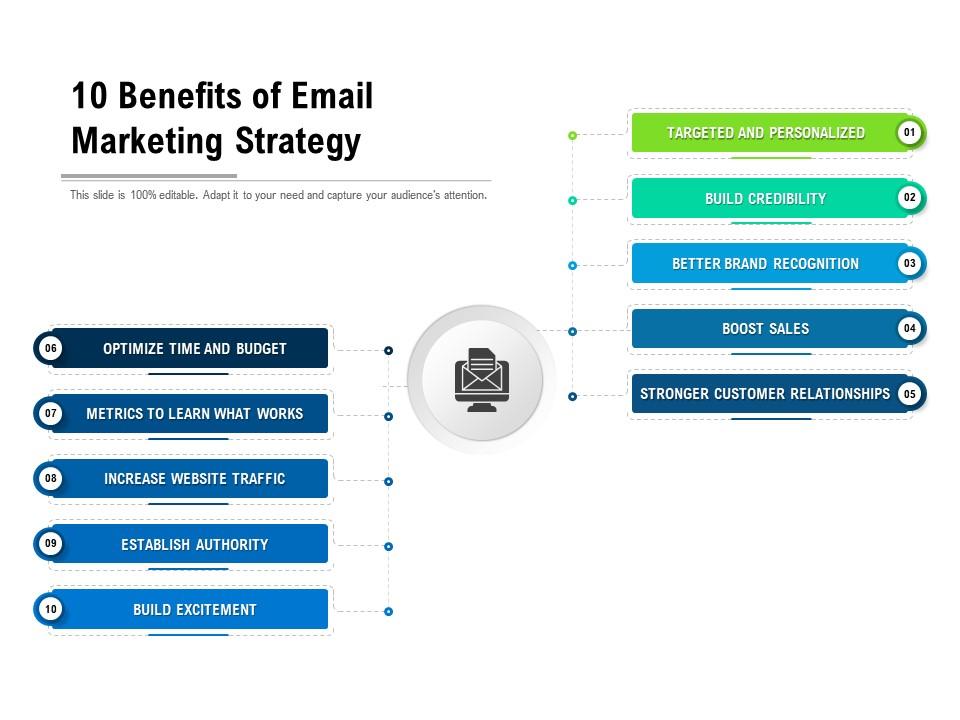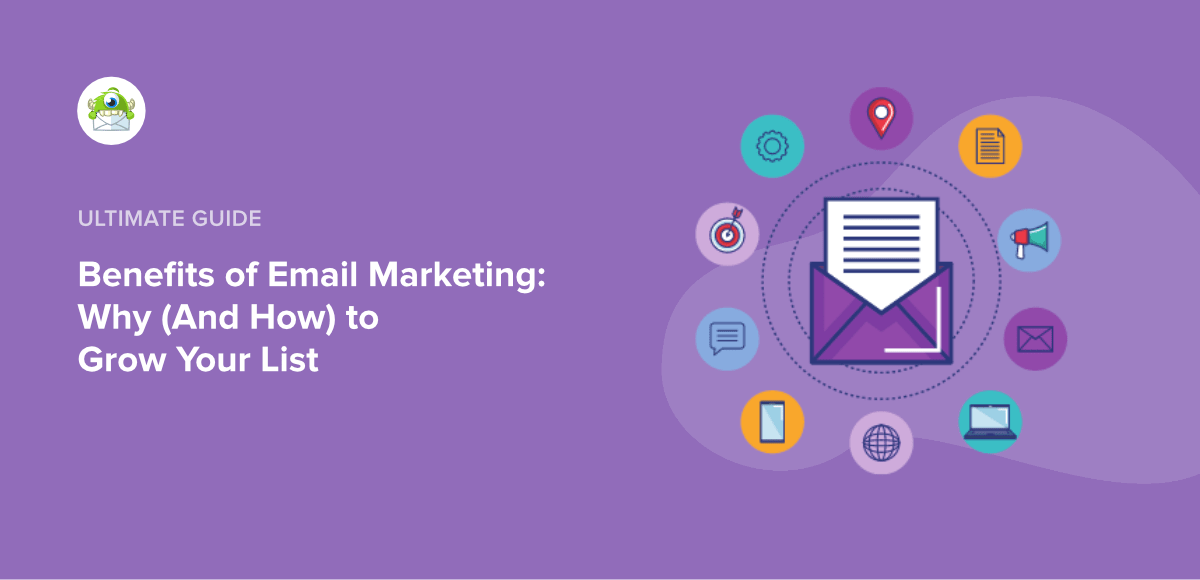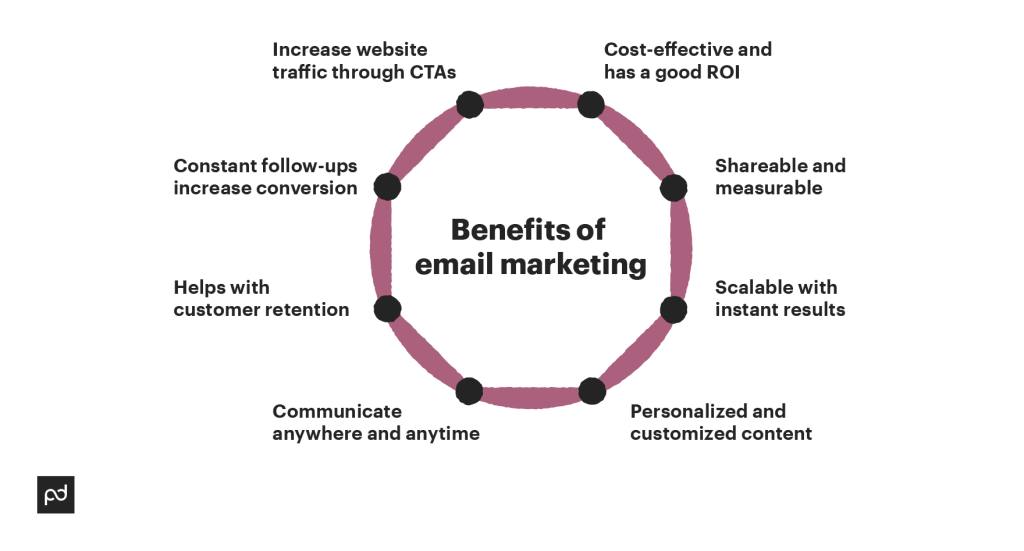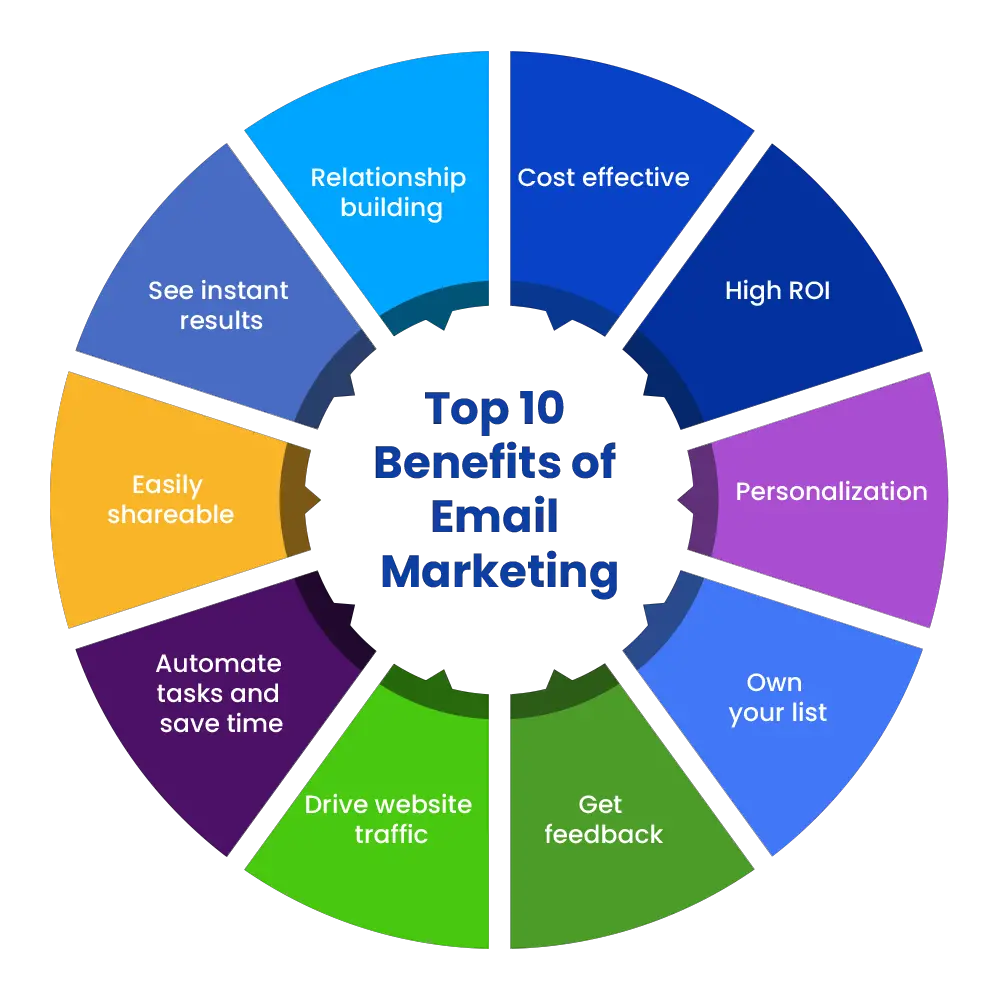Introduction
Email marketing boosts customer engagement and drives sales. It offers a cost-effective way to reach a targeted audience.
Email marketing is a powerful tool for businesses of all sizes. By sending personalized and relevant content, companies can connect directly with their customers. This method allows for precise targeting, ensuring messages reach the right audience. Email campaigns can be easily tracked, providing valuable insights into customer behavior and campaign performance.
With automation, businesses can efficiently manage and nurture leads, turning prospects into loyal customers. Additionally, email marketing is cost-effective, yielding a high return on investment. By integrating email marketing into your strategy, you can enhance brand awareness, foster customer loyalty, and ultimately drive more sales.

The Power Of Email Marketing
Email marketing is a powerful tool for businesses. It helps reach a large audience quickly. Emails can be personalized to fit customer needs. This makes email marketing very effective.
Emails can be sent to thousands of people at once. They can be customized with offers and information. This ensures customers feel valued and special.
High Reach Potential
Email marketing can reach a global audience. Emails can be sent anywhere in the world. This makes it a great tool for expanding your reach.
With email, you can communicate with many people at once. This saves time and effort. No other tool offers this kind of reach.
Here are some benefits of high-reach potential:
- Global audience
- Quick communication
- High engagement rates
Cost-effective Strategies
Email marketing is cost-effective. It is cheaper than traditional marketing methods. You do not need to print or mail materials.
Sending emails is quick and easy. This saves money and resources. You can also track your results easily.
Consider these cost-effective strategies:
- Use email templates
- Automate your emails
- Track and measure performance
In summary, email marketing offers high reach potential and cost-effective strategies. This makes it an essential tool for any business.
Building Strong Customer Relationships
Email marketing is a powerful tool for building strong customer relationships. It allows businesses to connect with their audience in a personalized and consistent manner. Customers feel valued when they receive tailored messages. This fosters loyalty and trust, enhancing the overall customer experience.
Personalization Tactics
Personalization can make a huge difference in email marketing. Use the recipient’s name in the email subject line. This simple tactic increases open rates. Segment your email list based on customer behavior and preferences. Send targeted content to each segment.
Consider the following personalization tactics:
- Use dynamic content to tailor emails.
- Send birthday or anniversary emails with special offers.
- Recommend products based on past purchases.
Personalized emails make customers feel special. They see that you understand their needs.
Consistent Engagement
Consistent engagement keeps your brand top of mind. Regular emails remind customers of your products and services. Share valuable content, such as tips, updates, and promotions. This keeps customers interested and engaged.
Here are some ideas for consistent engagement:
- Send a weekly or monthly newsletter.
- Announce new product launches or updates.
- Provide exclusive discounts and offers.
Engaging content builds anticipation. Customers look forward to your emails. This strengthens the bond between your brand and the customer.
| Personalization Tactics | Consistent Engagement |
|---|---|
| Use the recipient’s name | Send regular newsletters |
| Segment email lists | Announce product launches |
| Send targeted content | Offer exclusive discounts |
Email marketing, when done right, builds strong customer relationships. Personalization and consistent engagement are key elements. They ensure customers feel valued and connected to your brand.
Segmentation: Tailoring The Message
Email marketing excels in personalization. Segmentation allows you to divide your audience. This ensures each message is relevant. Tailoring your emails can boost engagement and conversions.
Behavioral Targeting
Behavioral targeting means sending emails based on user actions. Actions include clicks, purchases, and website visits. This method ensures content is relevant. It helps to improve open and click rates.
Consider a user who clicks on a product link. You can send a follow-up email with a discount. This can encourage the user to complete the purchase. Behavioral targeting makes emails more effective.
Demographic Segmentation
Demographic segmentation involves dividing your audience by age, gender, or location. This allows you to tailor messages to specific groups. For example, promoting products that fit their interests.
Let’s say you have two age groups: 18-25 and 45-60. You can send different emails to each group. Younger users may prefer trendy items. Older users might appreciate classic products.
| Age Group | Preferred Products |
|---|---|
| 18-25 | Trendy items, latest gadgets |
| 45-60 | Classic items, practical gadgets |
Using demographic data helps to improve email relevance. This can lead to higher engagement and sales.

Measurable Outcomes
Email marketing offers measurable outcomes. These metrics help you understand success. You can track opens, clicks, and conversions. This helps improve your campaigns.
Tracking Opens And Clicks
Tracking opens shows who reads your emails. This metric is vital. It tells you how engaging your subject lines are. Tools like Mailchimp or Constant Contact help track this.
Clicks are another key metric. They show which links get attention. This tells you what content interests your readers. Use this data to tailor future emails.
For example, if a link gets many clicks, you know it’s popular. You can create more content around that topic. This boosts engagement and keeps your audience interested.
Analyzing Conversion Rates
Conversion rates show how many readers take action. This could be a purchase, sign-up, or download. High conversion rates mean your email content is effective.
Use tools to track these conversions. Google Analytics is one such tool. It helps you see the journey from email to action. You can then tweak your emails for better results.
Here is an example of how you might track conversions:
| Email Campaign | Open Rate | Click Rate | Conversion Rate |
|---|---|---|---|
| Spring Sale | 20% | 5% | 2% |
| Newsletter | 30% | 7% | 3% |
This table shows how different campaigns perform. Use such data to refine your strategies. Focus on what works best for your audience.
Boosting Sales Through Direct Promotion
Email marketing is a powerful tool for boosting sales. Direct promotion through email allows businesses to reach customers quickly and effectively. By sending targeted and personalized messages, companies can drive more sales and increase revenue.
Exclusive Offers
One way to boost sales through email marketing is by offering exclusive deals. Customers love feeling special and getting unique discounts. By sending emails with special offers, businesses can encourage customers to make a purchase.
- Special discounts for email subscribers
- Limited-time promotions
- Exclusive access to new products
Create a sense of urgency with these offers. This can lead to quick sales and increased customer loyalty.
Time-sensitive Campaigns
Another effective strategy is to run time-sensitive campaigns. These campaigns encourage customers to act quickly. Limited-time offers create a sense of urgency and can drive immediate sales.
| Campaign Type | Duration |
|---|---|
| Flash Sales | 24 Hours |
| Weekend Specials | 48 Hours |
| Holiday Promotions | 1 Week |
Send reminder emails to ensure customers do not miss out on these deals. Time-sensitive campaigns can significantly boost sales in a short period.

Automated Campaigns For Efficiency
Email marketing automation is a game-changer for businesses. It saves time and boosts engagement. Automated campaigns streamline marketing tasks. This improves efficiency and drives better results.
Drip Campaign Benefits
Drip campaigns deliver information over time. They keep your audience engaged. Here are some key benefits:
- Consistent Communication: Drip campaigns send emails at regular intervals.
- Personalization: Tailor messages to each recipient’s behavior.
- Lead Nurturing: Guide prospects through the sales funnel.
- Time-Saving: Set up once and let the system work.
Trigger-based Emails
Trigger-based emails respond to user actions. They ensure timely communication. Here are some advantages:
| Trigger | Benefit |
|---|---|
| Welcome Emails | Greet new subscribers and set expectations. |
| Abandoned Cart | Remind users to complete their purchase. |
| Re-Engagement | Rekindle interest in inactive subscribers. |
| Post-Purchase | Thank customers and suggest related products. |
Using automated campaigns can transform your email marketing efforts. They provide efficiency and precision. This leads to higher engagement and conversions.
Integrating With Other Marketing Channels
Email marketing does not work alone. It becomes more powerful when integrated with other marketing channels. This integration creates a seamless experience for your audience. It enhances your overall marketing strategy. Below, we discuss how email marketing can synergize with social media and multi-channel campaigns.
Social Media Synergy
Email marketing and social media can work together. They amplify each other’s reach and effectiveness. Here are some ways to create synergy:
- Cross-Promotion: Share your email sign-up form on social media. This grows your email list.
- Exclusive Content: Offer special content in your emails that you tease on social media. This drives traffic to your emails.
- Social Proof: Include social media testimonials in your emails. This builds trust with your audience.
- Engage Followers: Use social media to announce your email newsletters. This keeps your followers engaged.
Multi-channel Campaigns
A multi-channel campaign uses various platforms to reach your audience. Email marketing is a key part of this. Here’s how to integrate email into your multi-channel campaigns:
- Consistent Messaging: Ensure your message is the same across all channels. This creates a unified brand voice.
- Timing: Coordinate the timing of your email and other marketing efforts. This maximizes impact.
- Track Performance: Use analytics to see how each channel performs. Adjust your strategy based on the data.
- Personalization: Tailor your messages based on the channel and audience behavior. This makes your campaign more effective.
Integrating email marketing with other channels strengthens your marketing strategy. It ensures a cohesive and effective approach to reaching your audience.

Staying Ahead With A/b Testing
Email marketing remains a powerful tool in the digital age. Staying ahead with A/B testing ensures your campaigns are always improving. By testing different versions of your emails, you can find what works best for your audience. This method helps in maximizing engagement and driving conversions.
Optimizing Email Elements
A/B testing allows you to optimize various email elements. Testing subject lines can help you see which ones get more opens. Try different lengths, tones, and keywords. Analyze the results to find the winning formula.
Test different email designs. Compare layouts, colors, and images. See which combination gets the most clicks and engagement. This process helps in creating visually appealing emails that your audience loves.
Experiment with call-to-action buttons. Test different text, sizes, and placements. Find out what encourages your readers to take action. This can lead to higher click-through rates and more conversions.
Iterative Improvements
Iterative improvements ensure your email marketing strategy evolves. With A/B testing, you can make small changes and measure their impact. This approach helps in fine-tuning your campaigns for better performance.
Start with a clear hypothesis. Decide what you want to test and why. Run the test and gather data. Analyze the results to see if your hypothesis is correct.
Repeat the process with new variables. Test different elements based on your previous findings. This iterative method helps in continuously improving your email marketing efforts.
Here is a quick reference table for common email elements to test:
| Email Element | Variables to Test |
|---|---|
| Subject Line | Length, Tone, Keywords |
| Email Design | Layout, Colors, Images |
| Call-to-Action | Text, Size, Placement |
- Test one element at a time for clear results.
- Run tests with a significant sample size.
- Use the data to inform future campaigns.
Compliance And Best Practices
Email marketing is a powerful tool. It connects businesses with customers. But, there are rules to follow. Compliance and best practices keep your campaigns effective. They also protect your reputation. Let’s explore the key areas of compliance and best practices.
Adhering To Regulations
Regulations keep email marketing fair and safe. They protect consumers from spam. Ignoring these rules can harm your business. Here are key regulations to follow:
- CAN-SPAM Act: This U.S. law sets rules for commercial emails. It gives recipients the right to stop emails. Breaking this law can lead to fines.
- GDPR: This is a regulation in the EU. It focuses on data protection and privacy. You must get consent before sending emails.
- CASL: This Canadian law covers all electronic messages. It requires clear consent and identification.
Following these regulations is crucial. It ensures your emails are legal and trustworthy.
Respecting Subscriber Preferences
Subscribers are the heart of your email marketing. Respecting their preferences builds trust. It also improves engagement. Here are best practices to follow:
- Easy Unsubscribe: Make it simple to opt-out. Every email should have a clear unsubscribe link.
- Personalized Content: Tailor emails to subscriber interests. Use data to send relevant content.
- Frequency Control: Let subscribers choose how often they get emails. This reduces complaints and unsubscribes.
Respecting preferences shows you value your subscribers. It creates a positive experience for them.
| Regulation | Region | Key Requirement |
|---|---|---|
| CAN-SPAM Act | U.S. | Right to stop emails, clear identification |
| GDPR | EU | Consent before sending, data protection |
| CASL | Canada | Clear consent, identification |
Future-proofing With Email Marketing Innovations
Email marketing is evolving fast. Innovative technologies keep businesses ahead. Staying updated ensures your campaigns remain effective and engaging. Explore how emerging technologies and predictive analytics can future-proof your email marketing strategy.
Emerging Technologies
New technologies enhance email marketing. These tools increase engagement and efficiency. Let’s discuss some key innovations.
- Artificial Intelligence (AI): AI personalizes email content. It analyzes user behavior and preferences.
- Machine Learning (ML): ML optimizes email send times. It learns from past interactions.
- Chatbots: Chatbots provide instant customer support. They can be integrated into email campaigns.
Predictive Analytics In Email
Predictive analytics uses data to forecast future outcomes. It helps in crafting targeted email campaigns. Here’s how it benefits email marketing:
| Benefit | Description |
|---|---|
| Personalization | Predictive analytics personalizes email content. It increases user engagement. |
| Customer Segmentation | It segments customers based on behavior. This ensures relevant content reaches the right audience. |
| Optimized Send Times | It predicts the best times to send emails. This boosts open and click rates. |
Using predictive analytics improves email campaign effectiveness. It drives better results and enhances customer experience.
Frequently Asked Questions
What Are The Benefits Of Email Marketing?
Email marketing is cost-effective and highly targeted. It helps in building strong customer relationships. It also increases brand awareness and drives conversions.
How Does Email Marketing Improve Customer Engagement?
Email marketing allows personalized communication. This fosters stronger customer relationships. Engaging content and timely updates keep customers interested and loyal.
Is Email Marketing Cost-effective?
Yes, email marketing is very cost-effective. It requires minimal investment. The return on investment (ROI) is high compared to other marketing channels.
Can Email Marketing Boost Sales?
Absolutely, email marketing can boost sales. Personalized offers and timely promotions encourage customers to make purchases. It also helps in upselling and cross-selling products.
Conclusion
Email marketing offers significant benefits for businesses. It helps boost engagement, improve customer retention, and drive sales. By leveraging targeted campaigns and personalized content, companies can effectively reach their audience. Embrace email marketing to enhance your digital strategy and achieve long-term success.
Start seeing the positive impact on your business today.

